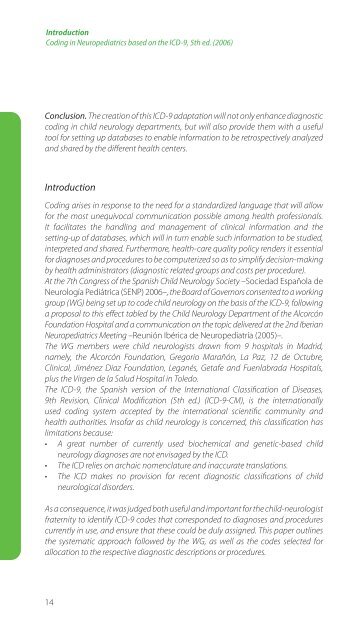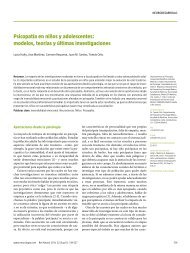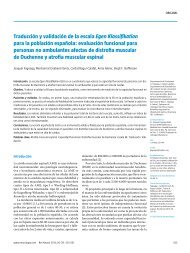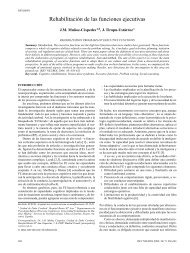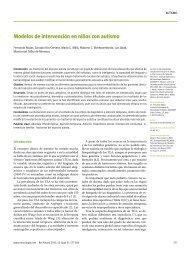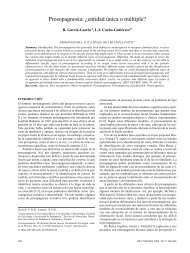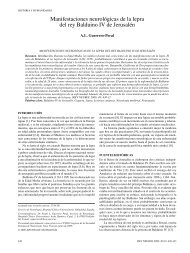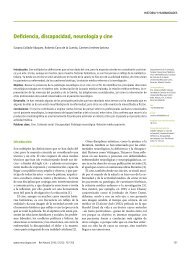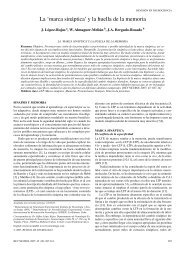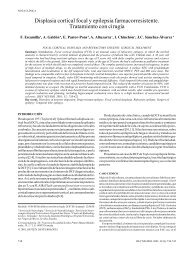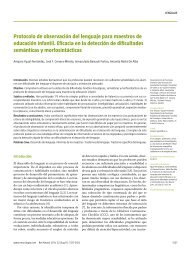Codificación en Neurología Pediátrica (CIE-9) - Revista de Neurología
Codificación en Neurología Pediátrica (CIE-9) - Revista de Neurología
Codificación en Neurología Pediátrica (CIE-9) - Revista de Neurología
You also want an ePaper? Increase the reach of your titles
YUMPU automatically turns print PDFs into web optimized ePapers that Google loves.
Introduction<br />
Coding in Neuropediatrics based on the ICD-9, 5th ed. (2006)<br />
Conclusion. The creation of this ICD-9 adaptation will not only <strong>en</strong>hance diagnostic<br />
coding in child neurology <strong>de</strong>partm<strong>en</strong>ts, but will also provi<strong>de</strong> them with a useful<br />
tool for setting up databases to <strong>en</strong>able information to be retrospectively analyzed<br />
and shared by the differ<strong>en</strong>t health c<strong>en</strong>ters.<br />
Introduction<br />
Coding arises in response to the need for a standardized language that will allow<br />
for the most unequivocal communication possible among health professionals.<br />
It facilitates the handling and managem<strong>en</strong>t of clinical information and the<br />
setting-up of databases, which will in turn <strong>en</strong>able such information to be studied,<br />
interpreted and shared. Furthermore, health-care quality policy r<strong>en</strong><strong>de</strong>rs it ess<strong>en</strong>tial<br />
for diagnoses and procedures to be computerized so as to simplify <strong>de</strong>cision-making<br />
by health administrators (diagnostic related groups and costs per procedure).<br />
At the 7th Congress of the Spanish Child Neurology Society –Sociedad Española <strong>de</strong><br />
<strong>Neurología</strong> <strong>Pediátrica</strong> (SENP) 2006–, the Board of Governors cons<strong>en</strong>ted to a working<br />
group (WG) being set up to co<strong>de</strong> child neurology on the basis of the ICD-9, following<br />
a proposal to this effect tabled by the Child Neurology Departm<strong>en</strong>t of the Alcorcón<br />
Foundation Hospital and a communication on the topic <strong>de</strong>livered at the 2nd Iberian<br />
Neuropediatrics Meeting –Reunión Ibérica <strong>de</strong> Neuropediatría (2005)–.<br />
The WG members were child neurologists drawn from 9 hospitals in Madrid,<br />
namely, the Alcorcón Foundation, Gregorio Marañón, La Paz, 12 <strong>de</strong> Octubre,<br />
Clinical, Jiménez Diaz Foundation, Leganés, Getafe and Fu<strong>en</strong>labrada Hospitals,<br />
plus the Virg<strong>en</strong> <strong>de</strong> la Salud Hospital in Toledo.<br />
The ICD-9, the Spanish version of the International Classification of Diseases,<br />
9th Revision, Clinical Modification (5th ed.) (ICD-9-CM), is the internationally<br />
used coding system accepted by the international sci<strong>en</strong>tific community and<br />
health authorities. Insofar as child neurology is concerned, this classification has<br />
limitations because:<br />
• A great number of curr<strong>en</strong>tly used biochemical and g<strong>en</strong>etic-based child<br />
neurology diagnoses are not <strong>en</strong>visaged by the ICD.<br />
• The ICD relies on archaic nom<strong>en</strong>clature and inaccurate translations.<br />
• The ICD makes no provision for rec<strong>en</strong>t diagnostic classifications of child<br />
neurological disor<strong>de</strong>rs.<br />
As a consequ<strong>en</strong>ce, it was judged both useful and important for the child-neurologist<br />
fraternity to id<strong>en</strong>tify ICD-9 co<strong>de</strong>s that correspon<strong>de</strong>d to diagnoses and procedures<br />
curr<strong>en</strong>tly in use, and <strong>en</strong>sure that these could be duly assigned. This paper outlines<br />
the systematic approach followed by the WG, as well as the co<strong>de</strong>s selected for<br />
allocation to the respective diagnostic <strong>de</strong>scriptions or procedures.<br />
14


